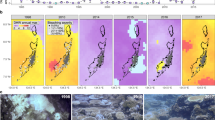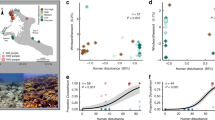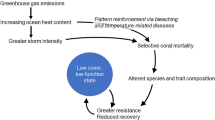Abstract
Climate change is radically altering the frequency, intensity and spatial scale of severe weather events, such as heatwaves, droughts, floods and fires1. As the time interval shrinks between recurrent shocks2,3,4,5, the responses of ecosystems to each new disturbance are increasingly likely to be contingent on the history of other recent extreme events. Ecological memory—defined as the ability of the past to influence the present trajectory of ecosystems6,7—is also critically important for understanding how species assemblages are responding to rapid changes in disturbance regimes due to anthropogenic climate change2,3,6,7,8. Here, we show the emergence of ecological memory during unprecedented back-to-back mass bleaching of corals along the 2,300 km length of the Great Barrier Reef in 2016, and again in 2017, whereby the impacts of the second severe heatwave, and its geographic footprint, were contingent on the first. Our results underscore the need to understand the strengthening interactions among sequences of climate-driven events, and highlight the accelerating and cumulative impacts of novel disturbance regimes on vulnerable ecosystems.
This is a preview of subscription content, access via your institution
Access options
Access Nature and 54 other Nature Portfolio journals
Get Nature+, our best-value online-access subscription
$29.99 / 30 days
cancel any time
Subscribe to this journal
Receive 12 print issues and online access
$209.00 per year
only $17.42 per issue
Buy this article
- Purchase on Springer Link
- Instant access to full article PDF
Prices may be subject to local taxes which are calculated during checkout



Similar content being viewed by others
Data availability
Source data are available online at the Tropical Data Hub (https://tropicaldatahub.org/).
References
AghaKouchak, A. et al. How do natural hazards cascade to cause disasters? Nature 561, 458–460 (2018).
Johnstone, J. F. et al. Changing disturbance regimes, ecological memory, and forest resilience. Front. Ecol. Environ. 14, 369–378 (2016).
Turner, M. G. Disturbance and landscape dynamics in a changing world. Ecology 91, 2833–2849 (2010).
Allen, M. et al. Global Warming of 1.5°C (IPCC, 2018); http://www.ipcc.ch/report/sr15
Hughes, T. P. et al. Spatial and temporal patterns of mass bleaching of corals in the Anthropocene. Science 359, 80–83 (2018).
Peterson, G. D. Contagious disturbance, ecological memory, and the emergence of landscape pattern. Ecosystems 5, 329–338 (2002).
Ogle, K. et al. Quantifying ecological memory in plant and ecosystem processes. Ecol. Lett. 18, 221–235 (2015).
Seidl, R. et al. Spatial variability in tree regeneration after wildfire delays and dampens future bark beetle outbreaks. Proc. Natl Acad. Sci. USA 113, 13075–13080 (2016).
Hughes, T. P. et al. Living dangerously on borrowed time during unrecognized regime shifts. Trends Ecol. Evol. 28, 149–155 (2013).
Puotinen, M. L. Tropical cyclones in the Great Barrier Reef region, 1910–1999: a first step towards characterising the disturbance regime. Aust. Geogr. Stud. 42, 378–392 (2004).
Baker, A. C., Glynn, P. W. & Riegl, B. Climate change and coral reef bleaching: an ecological assessment of long-term impacts, recovery trends and future outlook. Estuar. Coast. Shelf Sci. 80, 435–471 (2008).
Hughes, T. P. et al. Global warming transforms coral reef assemblages. Nature 556, 492–496 (2018).
Ainsworth, T. D. et al. Climate change disables coral bleaching protection on the Great Barrier Reef. Science 352, 338–342 (2016).
Thomas, L. & Palumbi, S. R. The genomics of recovery from coral bleaching. Proc. R. Soc. B 284, 20171790 (2017).
Torda, G. et al. Rapid adaptive responses to climate change in corals. Nat. Clim. Change 7, 627–636 (2017).
Guest, J. R. et al. Contrasting patterns of coral bleaching susceptibility in 2010 suggest an adaptive response to thermal stress. PLoS ONE 7, e33353 (2012).
Riegl, B. et al. Demographic mechanisms of reef coral species winnowing from communities under increased environmental stress. Front. Mar. Sci. https://doi.org/10.3389/fmars.2017.00344 (2017).
Bourne, D., Iida, Y., Uthicke, S. & Smith-Keune, C. Changes in coral-associated microbial communities during a bleaching event. ISME J. 2, 350–363 (2008).
Cunning, R., Silverstein, R. N. & Baker, A. C. Symbiont shuffling linked to differential photochemical dynamics of Symbiodinium in three Caribbean reef corals. Coral Reefs 37, 145–152 (2017).
Muller, E. M., Rogers, C. S., Spitzack, A. S. & Van Woesik, R. Bleaching increases likelihood of disease on Acropora palmata (Lamarck) in Hawksnest Bay, St. John, US Virgin Islands. Coral Reefs 27, 191–195 (2008).
Miller, J. et al. Coral disease following massive bleaching in 2005 causes 60% decline in coral cover on reefs in the US Virgin Islands. Coral Reefs 28, 925–937 (2009).
Williams, D. E., Miller, M. W., Bright, A. J., Pausch, R. E. & Valdivia, A. Thermal stress exposure, bleaching response, and mortality in the threatened coral Acropora palmata. Bull. Mar. Poll. 124, 189–197 (2017).
Pratchett, M. S., McCowan, D., Maynard, J. A. & Heron, S. F. Changes in bleaching susceptibility among corals subject to ocean warming and recurrent bleaching in Moorea, French Polynesia. PLoS ONE 8, e70443 (2013).
McClanahan, T. R. Changes in coral sensitivity to thermal anomalies. Mar. Ecol. Prog. Ser. 570, 71–85 (2017).
Hughes, T. P. et al. Global warming and recurrent mass bleaching of corals. Nature 543, 373–377 (2017).
Berkelmans, R., De’ath, G., Kininmonth, S. & Skirving, W. J. Comparison of the 1998 and 2002 coral bleaching events on the Great Barrier Reef: spatial correlation, patterns, and predictions. Coral Reefs 23, 74–83 (2004).
Liu, G. et al. NOAA Coral Reef Watch’s 5 km Satellite Coral Bleaching Heat Stress Monitoring product suite version 3 and Four-Month Outlook version 4. Reef Encounter 32, 39–45 (2017).
Coral Reef Watch Satellite Monitoring and Modeled Outlooks (NOAA, 2018); https://coralreefwatch.noaa.gov/satellite/index.php
Hartig, F. DHARMa: Residual Diagnostics for Hierarchical (Multi-Level/Mixed) Regression Models R package version 0.1.5 (R Foundation for Statistical Computing, 2017); https://CRAN.R-project.org/package=DHARMa
Acknowledgements
The authors acknowledge support from the Australian Research Council’s Centres of Excellence programme, Australian Institute of Marine Science and US National Oceanic and Atmospheric Administration. The scientific results and conclusions, as well as any views or opinions expressed herein, are those of the authors and do not necessarily reflect the views of NOAA or the US Department of Commerce.
Author information
Authors and Affiliations
Contributions
The study was conceptualized and led by T.P.H., who also wrote the first draft of the paper. All authors contributed to writing subsequent drafts. J.T.K. coordinated data compilation, analysis and graphics. J.T.K. and T.P.H. conducted the aerial bleaching surveys in 2016 and 2017. Underwater assessments and ground-truthing of aerial scores were performed by A.H.B., A.S.H., M.O.H., M.S.P. and G.T. S.F.H., C.M.E., G.L. and W.S. provided satellite data on heat stress. S.R.C. and M.J. contributed statistical and modelling expertise.
Corresponding author
Ethics declarations
Competing interests
The authors declare no competing interests.
Additional information
Publisher’s note: Springer Nature remains neutral with regard to jurisdictional claims in published maps and institutional affiliations.
Supplementary information
Supplementary Information
Supplementary Figures 1–4
Supplementary Movie 1
Video footage from helicopter over Beesley Island Reef (143.21° E, 12.25° S) during aerial surveys of mass coral bleaching in March 2016
Supplementary Movie 2
Underwater video footage of widespread coral mortality at Zenith Reef (143.61° E,12.77° S) during coral surveys in November 2016
Rights and permissions
About this article
Cite this article
Hughes, T.P., Kerry, J.T., Connolly, S.R. et al. Ecological memory modifies the cumulative impact of recurrent climate extremes. Nature Clim Change 9, 40–43 (2019). https://doi.org/10.1038/s41558-018-0351-2
Received:
Accepted:
Published:
Issue Date:
DOI: https://doi.org/10.1038/s41558-018-0351-2
This article is cited by
-
Research progresses and prospects of multi-sphere compound extremes from the Earth System perspective
Science China Earth Sciences (2024)
-
Local habitat heterogeneity rivals regional differences in coral thermal tolerance
Coral Reefs (2024)
-
Disturbance intensification is altering the trait composition of Caribbean reefs, locking them into a low functioning state
Scientific Reports (2023)
-
Linking differences in microbial network structure with changes in coral larval settlement
ISME Communications (2023)
-
Hidden heatwaves and severe coral bleaching linked to mesoscale eddies and thermocline dynamics
Nature Communications (2023)



